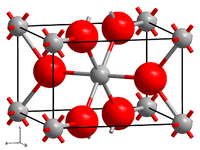Tin (IV) oxide
| Crystal structure | ||||||||||||||||
|---|---|---|---|---|---|---|---|---|---|---|---|---|---|---|---|---|

|
||||||||||||||||
| __ Sn 4+ __ O 2− | ||||||||||||||||
| General | ||||||||||||||||
| Surname | Tin (IV) oxide | |||||||||||||||
| other names |
|
|||||||||||||||
| Ratio formula | SnO 2 | |||||||||||||||
| Brief description |
amorphous, white powder or hexagonal, tetragonal or rhombic crystals |
|||||||||||||||
| External identifiers / databases | ||||||||||||||||
|
||||||||||||||||
| properties | ||||||||||||||||
| Molar mass | 150.71 g · mol -1 | |||||||||||||||
| Physical state |
firmly |
|||||||||||||||
| density |
6.95 g cm −3 (20 ° C) |
|||||||||||||||
| Melting point |
1630 ° C |
|||||||||||||||
| solubility |
|
|||||||||||||||
| Refractive index |
1.9968 (20 ° C) |
|||||||||||||||
| safety instructions | ||||||||||||||||
|
||||||||||||||||
| Toxicological data | ||||||||||||||||
| As far as possible and customary, SI units are used. Unless otherwise noted, the data given apply to standard conditions . Refractive index: Na-D line , 20 ° C | ||||||||||||||||
Tin (IV) oxide , also known as tin dioxide , is the main component of the mineral cassiterite (tin stone) and the main source of pure tin .
Extraction and presentation
Tin (IV) oxide can be obtained by burning tin in air , by reacting tin (IV) chloride and water (both as steam) at high temperatures, and by reacting tin with sulfuric acid and then with hydroxides .
Chemical properties
The water-insoluble, amphoteric tin dioxide dissolves in strong acids such as hydrochloric acid or hydriodic acid with the formation of the corresponding hexahalogen stannates:
The salts of the partly free non-existent tin acids H 2 [Sn (OH) 6 ] and H 2 SnO 3 ( metatin (IV) acid ) are formed with strong alkalis . The corresponding alkali salts such as Na 2 SnO 3 or Na 2 [Sn (OH) 6 ] are stable and are used in the dyeing industry , such as the sodium stannate Na 2 [Sn (OH) 6 ].
use
Tin (IV) oxide is used as a semiconductor ingredient, such as together with antimony oxide (III) as ATO , Antimony-Tin-Oxide and as FTO ( Fluorine doped Tin Oxide ), for the photovoltaic in Grätzel cell used. Tin dioxide is also used in optical fibers or LC displays - here it serves as a transparent, electrically conductive layer - and in gas sensors , where it reacts with a change in resistance to all oxidizable gases or vapors.
It is also used as a polishing powder for steel , glass and natural stone , as a white, transparent opacifier in the production of ceramic glazes , milk glass and enamel , for sealing cracks in glass and as a catalyst in chemical processes. Tin (IV) oxide used to be used as a glaze in the manufacture of faience . It is also used as an electrode material when melting inorganic glasses. It is mainly used as a replacement for molybdenum electrodes when melting lead glasses .
In electromechanical switchgear such as B. Protect , the contact material often consists of silver with 2–14% by weight SnO 2 . Since many manufacturers have avoided cadmium in particular , the previously used cadmium oxide has been replaced by tin oxide.
Individual evidence
- ↑ Entry on TIN OXIDE in the CosIng database of the EU Commission, accessed on February 17, 2020.
- ↑ a b c Entry on tin oxides. In: Römpp Online . Georg Thieme Verlag, accessed on December 22, 2014.
- ↑ a b c d Entry on tin dioxide in the GESTIS substance database of the IFA , accessed on December 19, 2019(JavaScript required) .
- ↑ Data sheet Tin (IV) oxide, Puratronic®, 99.996% (metals basis) from AlfaAesar, accessed on February 1, 2017 ( PDF )(JavaScript required) .
- ^ Donaldson & Grimes: Chemistry of tin ed. PG Harrison Blackie (1989).
- ↑ Earle R. Caley: The Action Of Hydriodic Acid On Stannic Oxide . In: J. Am. Chem. Soc. , 1932, 54, 8, pp. 3240-3243, doi : 10.1021 / ja01347a028 .
Web links
- optical properties (PDF; 400 kB)
![{\ displaystyle \ mathrm {SnO_ {2} \ + \ 6 \ HI \ \ longrightarrow \ \ H_ {2} [SnI_ {6}] \ + \ 2 \ H_ {2} O}}](https://wikimedia.org/api/rest_v1/media/math/render/svg/b09b897c5e2efd0c42f4ae4323a943c922cfbc4d)


